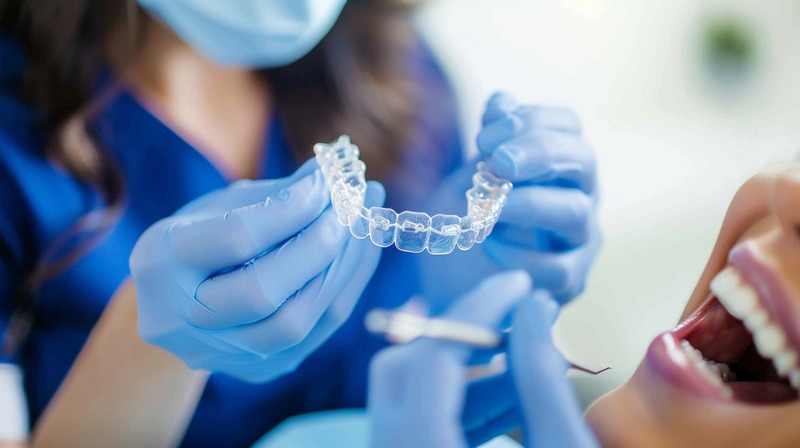Orthodontic care is crucial in maintaining oral health and enhancing quality of life. By addressing misaligned teeth, overbites, and underbites, orthodontic treatments improve aesthetic appearance and prevent the long-term risk of dental complications. Proper alignment facilitated by orthodontics can ease chewing, reduce excessive wear on tooth enamel, and help in effective oral hygiene, making it an essential aspect of dental care.
Beyond just improving the appearance of a smile, orthodontic care has profound effects on overall oral health, function, and self-esteem. Here’s an in-depth look at why orthodontic care is so crucial:
1. Enhances Dental Health
Proper alignment of teeth and jaws is fundamental to maintaining optimal dental health. When teeth are crooked or misaligned, it becomes challenging to clean them effectively. Misaligned teeth create tight spaces where plaque and food particles accumulate, leading to a higher risk of tooth decay and gum disease. Orthodontic treatments straighten the teeth, making it easier to brush and floss thoroughly and thus reducing the risk of oral health issues.
If you’re considering orthodontic treatment, it may be helpful to locate their office on Google Maps to find a convenient and reputable orthodontist near you. By improving alignment, orthodontics facilitates better oral hygiene practices, which are essential for preventing cavities and maintaining healthy gums.
2. Improves Functional Efficiency
Teeth and jaws must function harmoniously for adequate chewing, biting, and speaking. Misaligned teeth or an incorrect bite can interfere with these essential functions, leading to difficulty chewing food properly and affecting digestion. An improper bite may also cause speech impediments or difficulty pronouncing certain words.
Orthodontic care addresses these functional issues by correcting the alignment of the teeth and jaws, thus enhancing overall mouth function and making daily activities such as eating and speaking more comfortable and efficient.
3. Prevents Future Dental Complications
Early intervention through orthodontic care can prevent more severe dental problems from developing. For example, crowded teeth can lead to uneven wear and tear, increased risk of decay, and periodontal disease. Misaligned bites can contribute to jaw pain, headaches, and temporomandibular joint (TMJ) disorders.
By addressing these issues early, orthodontic treatment can prevent the progression of these problems, reducing the likelihood of more complex and costly treatments later on. Preventing these complications ensures long-term oral health and reduces the risk of more serious dental concerns.
4. Boosts Self-Esteem and Confidence
The aesthetic appearance of one’s smile significantly impacts self-esteem and confidence. Crooked, crowded, or protruding teeth can cause self-consciousness, affecting social interactions and personal self-image. Fortunately, orthodontic services in Conroe provide advanced treatments to improve the alignment and appearance of the teeth, leading to a more aesthetically pleasing smile.
This enhancement in appearance boosts self-confidence, leading to improved social and professional interactions and a more positive self-perception. A confident smile contributes to better personal relationships and enhances overall well-being.
5. Facilitates Healthy Jaw Development
Orthodontic care is essential for children and adolescents to guide healthy jaw and tooth development. Early orthodontic treatment can influence tooth alignment and jaw development during the growth phases. Appliances like spacers or expanders can address issues like a narrow palate or insufficient space for incoming permanent teeth.
Guiding this development helps ensure that the teeth and jaws grow favorably, which can reduce the need for more extensive treatments later and ensure proper alignment as permanent teeth come in.
6. Reduces the Risk of Dental Injuries
Misaligned or protruding teeth are more vulnerable to dental injuries. For example, teeth that stick out are at a higher risk of being damaged during physical activities or accidents. Orthodontic treatments can reposition these teeth, reducing the likelihood of injury and protecting the teeth from excessive force or trauma. By aligning the teeth properly, orthodontics also helps distribute biting forces evenly, minimizing the risk of damage and wear on individual teeth.
7. Improves Bite Alignment
Orthodontics addresses issues such as overbites, underbites, crossbites, and open bites. An improper bite can lead to several problems, including difficulties with chewing, uneven wear on teeth, and strain on the jaw muscles. Correcting these bite issues through orthodontic care ensures a balanced bite, contributing to more efficient chewing and a harmonious appearance. Proper bite alignment also helps alleviate strain on the jaw and prevent associated discomfort or pain.
8. Facilitates Better Oral Hygiene
Straight teeth are easier to clean, which improves overall oral hygiene. When teeth are correctly aligned, brushing and flossing become more effective, reducing the buildup of plaque and tartar. This easier maintenance lowers the risk of dental issues such as cavities and gum disease. By aligning teeth and correcting bite issues, orthodontic care facilitates better oral hygiene, leading to healthier teeth and gums.
9. Provides Long-Term Health Benefits
The benefits of orthodontic care extend well beyond the duration of treatment. Achieving proper alignment and bite correction contributes to long-term oral health improvements. Well-aligned teeth and jaws support better oral hygiene, prevent future dental problems, and enhance overall function and comfort. The long-term advantages of orthodontic treatment include a healthier mouth, improved quality of life, and reduced likelihood of needing more extensive dental procedures.
10. Addresses Speech and Functional Issues
Misaligned teeth or jaw issues can sometimes affect speech and other functional aspects. Orthodontic treatment can help correct these issues by properly aligning the teeth and jaws. For instance, a misaligned bite can impact pronunciation, while crooked teeth make certain sounds challenging to articulate. By improving alignment, orthodontic care can enhance speech clarity and overall communication skills, improving social interactions and self-expression.
Final Thoughts
Orthodontic care is a crucial component of maintaining and improving oral health. It addresses misalignments of the teeth and jaws, leading to better dental health, improved functionality, and enhanced aesthetics. By preventing future complications, boosting self-esteem, and facilitating healthy jaw development, orthodontic treatments offer long-term benefits that contribute to overall well-being. Investing in orthodontic care provides significant advantages for children or adults, ensuring a healthier, more confident, and comfortable smile for years.





